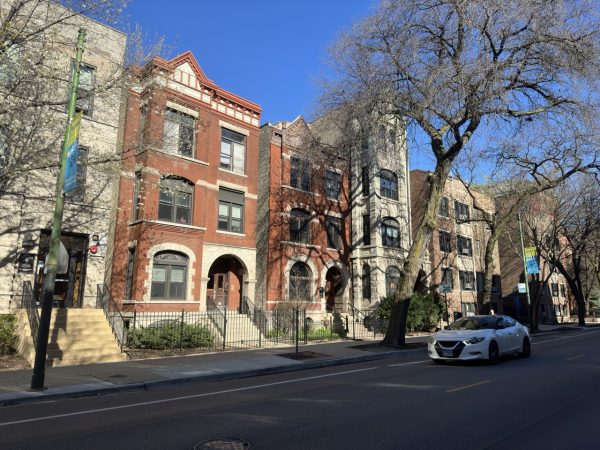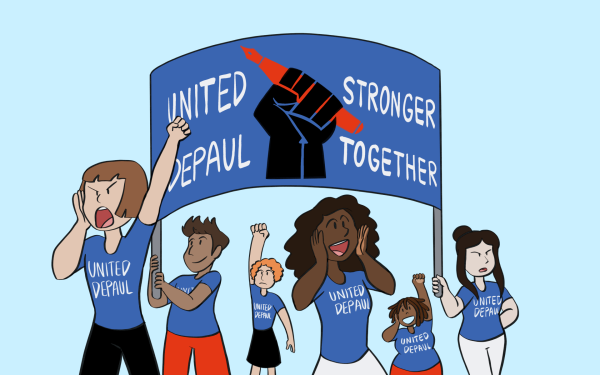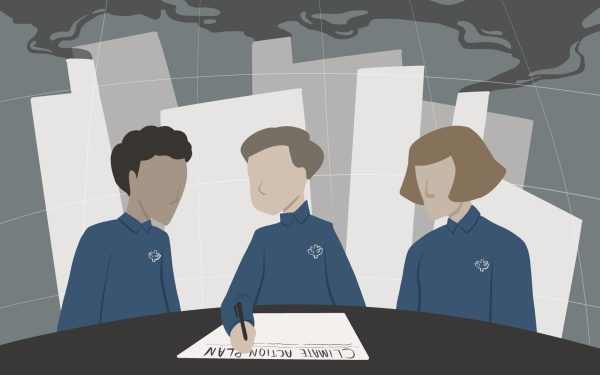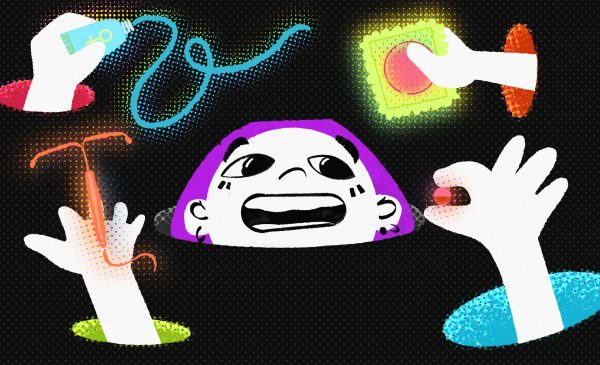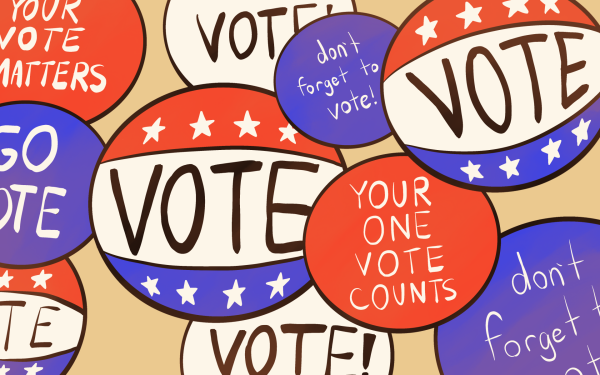Professors adjust to the return to campus after teaching online
Students walk around a mostly empty campus during the pandemic.
In the time since the fateful March of 2020, DePaul professors have dealt with many changes to their class formats. The slow transition back to in-person classes and campus life has brought both new challenges and new habits.
Caryn Chaden is an Associate Provost helping DePaul to navigate and communicate this transition and the Covid regulations that come with it. She said the university has gone to great lengths to make online teaching more manageable.
When Covid struck, 4,000 classes were forced to move online. Since then, the Instructional Designers in the Center for Teaching and Learning have been guiding about 200 professors through online teaching workshops. The university also used money from the government to buy extra monitors and speakers, enabling about 100 classes to have a flex option, where students can decide whether to come in person or log onto zoom, she said.
“This fall is more complicated than last fall,” she said. “Last fall, we were just all at home.”
Starting in-person classes again is not as simple as going back to normal. Returning to campus means complying with the governor’s orders to wear masks and either get vaccinated or take regular Covid tests. Some practices are also starting to shift outside of the requirements that have been set.
“I think we are seeing that it totally depends on the program. And it depends on the person, too,” she said.
Acting classes and chemistry labs are just some areas that do not translate well, but the College of Business is still offering many online classes since students with jobs downtown appreciate the flexibility. At this point, even with the green light to come back, around a third of classes remain online, compared to 15% before the lockdown. While the switch from online was abrupt and difficult to manage at first, she thinks there have been benefits for the long run.
“I think people have learned a lot about how to teach online more effectively than when we first started last spring. And so I think some of those practices are sticking,” she said.
For the immunocompromised and disabled, online classes offer more than convenience. Computing and Digital Media professor Jessica Westbrook’s Type 1 diabetes made it essential to continue teaching online this quarter because of a new rule prohibiting eating and drinking in class. She empathizes with students who are in the same situation.
“Ableism is pervasive and difficult. Calculated risk is not standardized,” she shared in an email. “Many folks have been navigating layers of health and safety – even before the pandemic. The disregard for vulnerable populations since March 2020 has changed the way I understand things. It has been clarifying, but also heavy. I’m glad to be offering online classes for students who need and like them,” she said.
Jakub Rudnik came to DePaul to start his teaching career in the spring of 2020. In his classes—Intro to Online Production and Reporting, an Adobe Audition workshop and an InDesign workshop—he’s experienced the whole range of classroom settings, from fully online to hybrid and in-person models.
Rudnik’s workshop classes have always been online. He said seeing names and faces in front of him over zoom helped him get organized and acclimated to his role. Still, teaching from a computer brought some difficulties. Although he had used zoom before, dealing with the technology in a classroom setting was very different. Here, he had to manage internet issues on top of teaching his lesson, and the rhythm of an in-person lecture or discussion didn’t translate. He said, and I think many of us have experienced, that there was much less engagement in the online format.
“You would just be looking at blank screens with people’s names and maybe their picture, three people would have their face on even if you were encouraging it, you’re getting answers like pulling teeth,” he said. “Online just felt pointless sometimes—you always feel occasionally like a student is zoning out … but when everyone’s cameras are off and you’re getting no reception, that was the hardest.”
In the hybrid style, the class was split in half, and the two groups took turns coming in and working from home. Rudnik’s class was the only one on his floor, held in a large room, and usually consisted of three to eight in-person students. In terms of Covid safety, he said it was “as good as it could be”.
However, these first classes were held before the vaccine became available. Rudnik took extra measures to be sure he wasn’t taking the virus back to his wife and parents, like driving through traffic instead of taking the train.
“I was nervous to some extent until I was vaccinated. That definitely changed my mindset,” he said.
It was also more complicated to deal with multiple teaching styles at once.
“There was so much going on, you’re teaching two things at the exact same time and trying to format your lessons to both, which means you’re really formatting your lessons to neither sometimes,” he said.
In comparison, he said fully in-person classes have been the most natural and helpful for teaching.
“We’re only four weeks in but I feel very good about this quarter … The engagement levels are far higher than they were in the spring. I’ve never felt the energy like this as a professor, so I’m certainly very happy that it’s back in person,” he said.



